Lord Shiva (full) information (facts) (details) – Part 2 of 2
Namaste friends, how are you doing today? Welcome to #BhagavanBhakthi website / blog.
Bhagavan Lord Sri Vishnu (Krishna) and Lord Shiva blessings to you and your family!
In this website / blog, you will always learn about #Hinduism #Sanskrit language.
Also subscribe to my YouTube channel from this link #BhagavanBhakthi to view videos about #Hinduism #Sanskrit language.
Just before going to “Lord Shiva (full) information (facts) (details) – Part 2 of 2“, let us know a brief, basic and very important information.
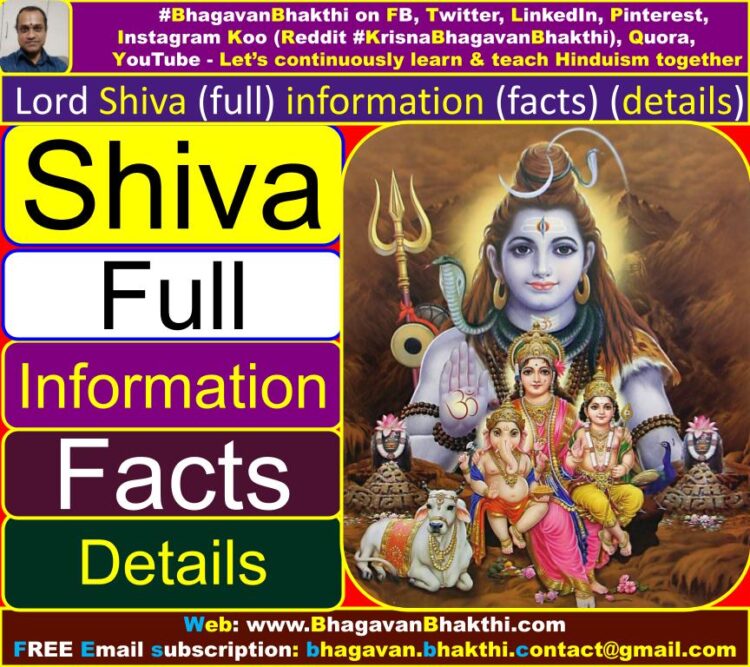
This is been continued from “Lord Shiva (full) information (facts) (details) – Part 1 of 2”.
List of different Lord Shiva names with meanings is as given below:
Andhakasura Hara : Lord Shiva killed a demon named Andhakasura and thus the name Andhakasura Hara, that is, “someone who has killed the demon by name Andhaka“.
Kamari (Kaamaari) : Lord Shiva burnt alive Lord Sri Kama Deva (Manmatha). This happened when all the Devatas (Demigods) sent Lord Sri Kama Deva to break the penance of Lord Shiva.
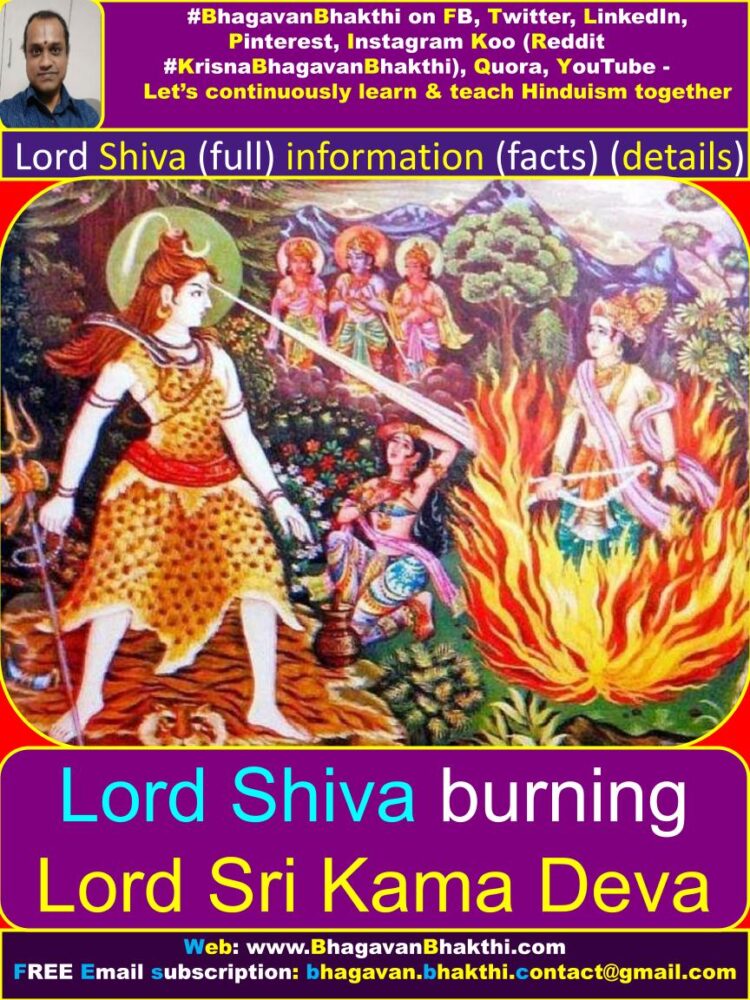
Lord Sri Kama Deva throws his kama arrow (lusty arrow) on Lord Shiva, which made Lord Shiva angry and he opened his third eye and thus Lord Sri Kama Deva was burnt in to ashes immediately.
Here Kaamaari = Kaama + Ari = Lord Sri Kaama Deva + ari = killing. This means, Lord Shiva is someone who had killed Lord Sri Kama Deva.
Ashutosh (Ashutosha) : As Lord Shiva gives the boon very early to all who do tapas of himself (Lord Shiva). Ashutosha means someone who gives the boon very very fastly.
Nandi Vahana – Lord Shiva has Nandi as his vahana (vehicle / mount). Nandi is the one on which Lord Shiva raids.
Aghora : This is the form which Lord Shiva took to kill the 3 demons called as Tripurasuras (Tarakaksha, Vidyunmāli and Kamalaksha).
Chandrashekara / Somashekara : Lord Shiva has Lord Sri Chandra Deva (Also called as Lord Sri Soma Deva) on his head.
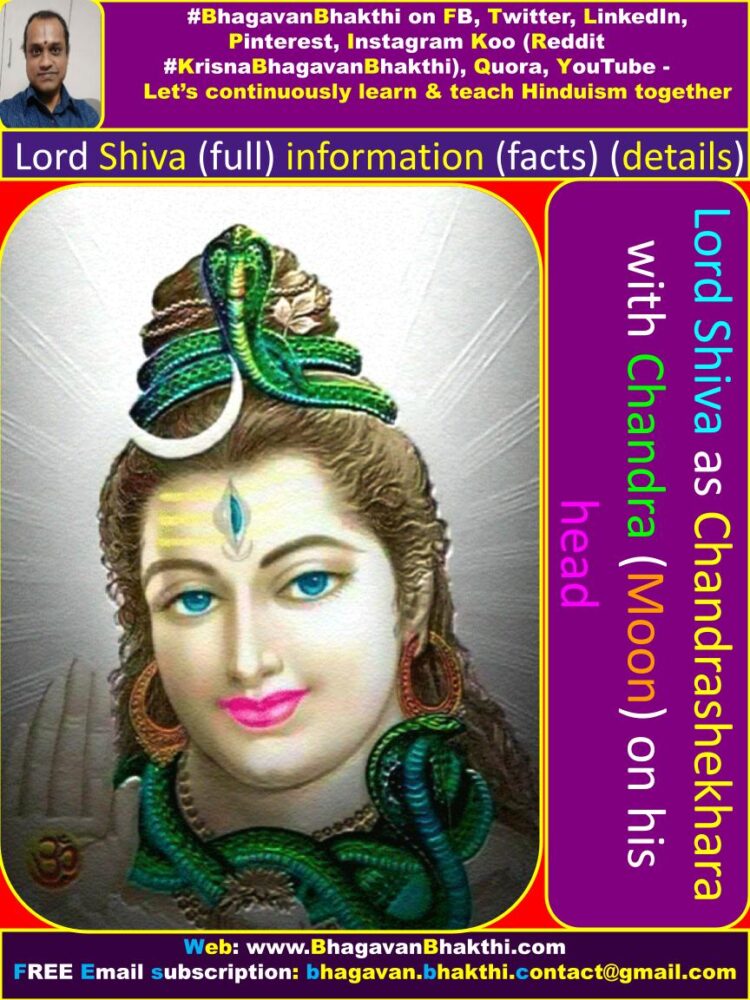
Gangadhara : Lord Shiva always has Goddess Sri Ganga Devi on his head. Some poets, novelists have called Sri Ganga Devi as the wife of Lord Shiva, which is completely incorrect.
Goddess Sri Ganga Devi was never the wife of Lord Shiva. Goddess Sri Ganga Devi is the wife of Lord Sri Varuna Deva.
Lord Shiva was holding her as she requested him to give some place in him and Goddess Sri Ganga Devi had vishesha sannidhana (special divine presence) of Lord Sri Vishnu.
This special divine presence is because, as Goddess Sri Ganga Devi is the Lord Sri Vishnu’s paadodaka (taking birth from the paada / foot of Lord Sri Vishnu).
Damarugapani : Lord Shiva has Damaruga (Damru) in one of his hands, while doing tandava / dancing.
[The English word drum is originated from this Sanskrit word Damaruga (Damaru) (Damru).]
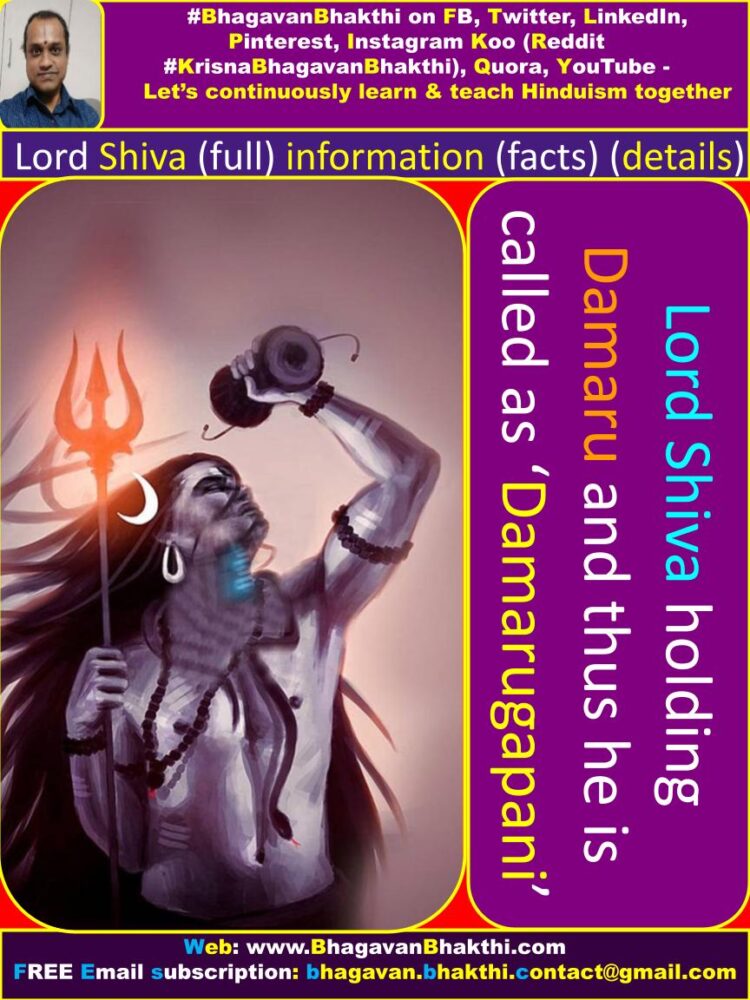
Gajasuramardhana : An asura (demon) called Neela came in the disguise of an elephant as Gajasura (गजासुर), who entered the body of an elephant and attacked Lord Shiva.
Lord Shiva also entered the body of that elephant and did the Tandava nritya (dance) there itself and killed the asura (demon) Gajasura from within the elephant.
Thus he is called as Gajasuramardhana (Gaja = elephant, asura = rakshasa / demon, mardhana = killing).
(The English word murder is originated from this Sanskrit word mardhana or mardhan or mardhanam.)
Doorjati (Durjati) : Lord Shiva has जटा (jaṭā) (JaTaa) (matted hairs) on this head.
Gajacharmambaradhara : Lord Shiva has killed an asura (demon) named Gajasura by entering the body of an elephant.
And Lord Shiva was covered with the body of an elephant when Lord Shiva did the Tandava Nritya (dance) inside the body of an elephant.
Thus Lord Shiva is called as Gajacharmambaradhara (Gaja = elephant, charmambara = body, dhara = holding).
Kailashavaasa (Kailashavasa) : Lord Shiva lives in Kailasha (Kailash) (Kailashavaasa – Kailasha = Sky, vaasa = living). He is someone who lives in an abode called Kailasha (Kailash).
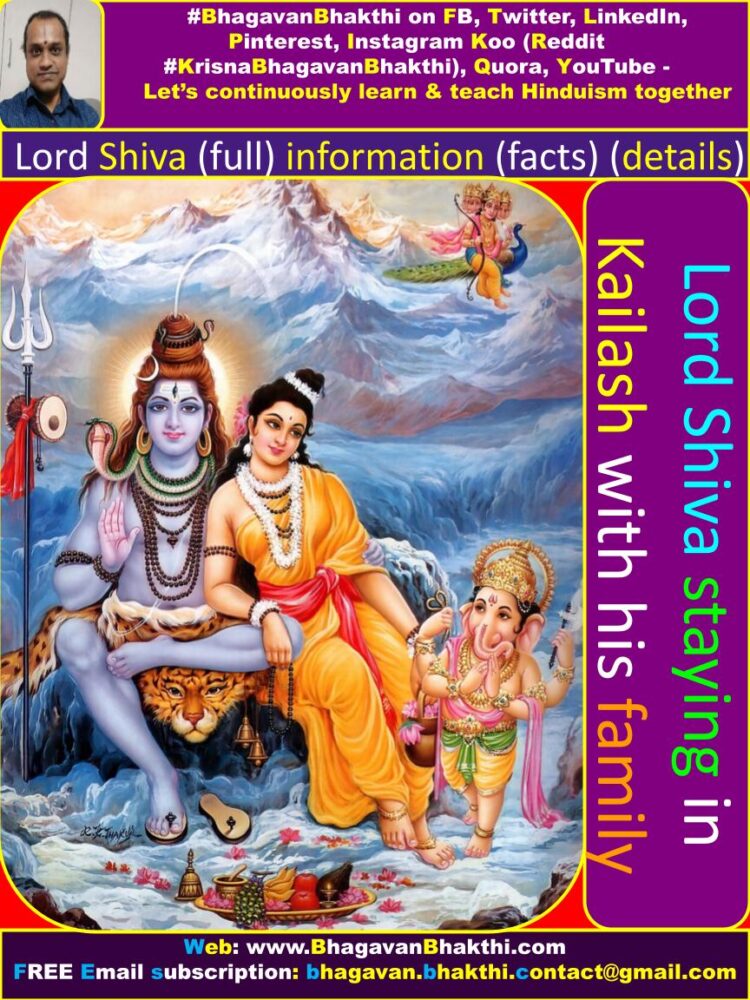
Krithivaasa : Lord Shiva wears praani charma (animal skin) as his dress and thus he is also called as Charmambaradara for the same reason.
Manoniyamaka : Lord Shiva controls the chitta (mana / mind) of all the jeevis (beings) starting from Goddess Sri Parvati Devi, Lord Sri Indra Deva and all the Devatas (Demigods) and others.
Maheshvara : Lord Shiva is superior to Goddess Sri Parvati Devi, Lord Sri Indra Deva, Lord Sri Surya Deva, etc. that is, all the Devatas (Demigods).
Mrityunjaya : Lord Shiva has more power than the so called Mrityu Devata (God of death), that is, Lord Sri Yama Deva. Young Markandeya had a very short life of only 16 years.
Thus, Markandeya was known that his life is very short. Thus, Markandeya worshipped Lord Shiva with utmost devotion.
After the completion of 16th year, Lord Sri Yama Deva came to take Markandeya’s life by pulling him with his arrows.
Lord Shiva came and rescued Markandeya by fighting with Lord Sri Yama Deva. After defeating Lord Sri Yama Deva, Lord Shiva blessed Markandeya with Chiranjeevatva (Very long life).
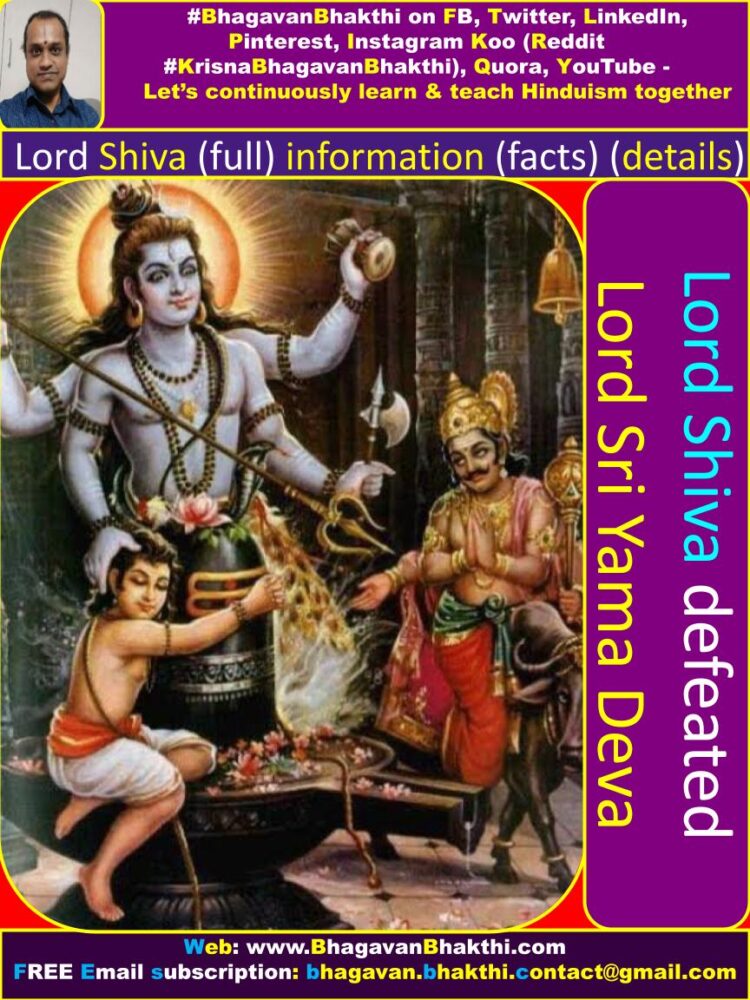
That is why Markandeya (Maharishi Markandeya) is considered as one of the Chiranjivi.
Nataraja : Lord Shiva is an expert in doing Tandava Natya (dance). He is the expert dancer of Tandava Natya and thus the same Nataraja.
Nagabharana : Lord Shiva wears sarpa (serpent) as one of his ornaments. Nagabharana = Naga + Abharana = He is someone who wears snakes as his ornaments.
Nagabhushana : Lord Shiva has sarpa (serpent) around his neck. Nagabhushana – Naga = sarpa / serpent, bhushana = wearing. He is someone who wears snakes.
Neelakantha : Lord Shiva’s throat color turned blue after drinking ‘halahala visha‘ (poison) during the amrita manthan (Samudra manthan) period.
Parvatisha (Paarvatisha) : Lord Shiva is the Isha (Lord) of Goddess Sri Parvati Devi. Parvatisha = Parvati + Isha.
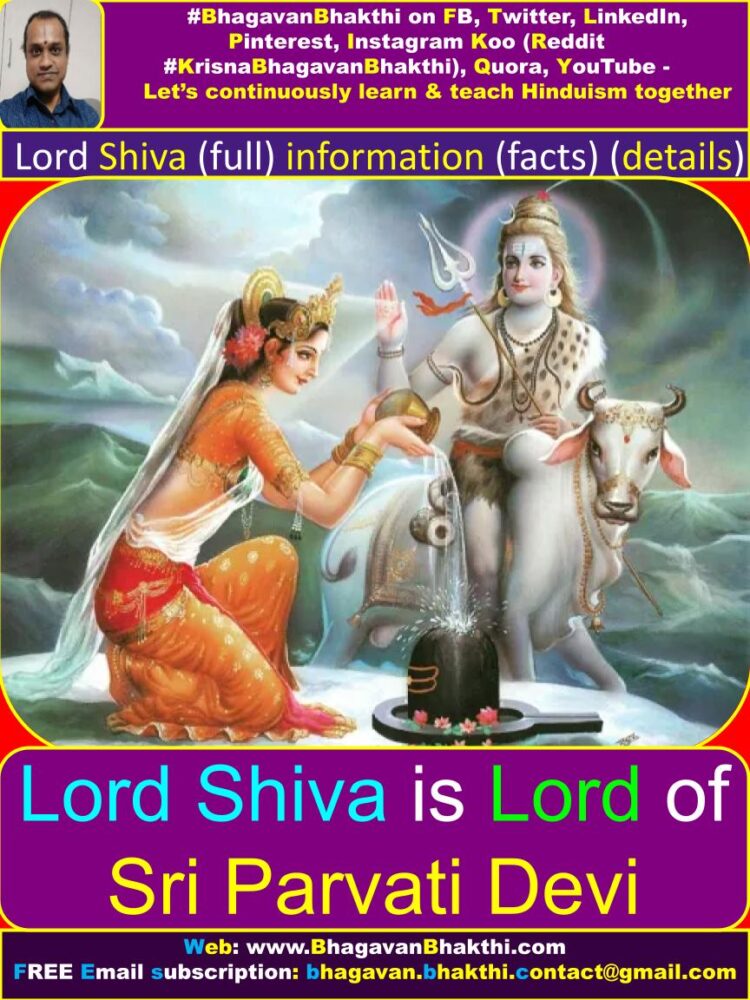
Pinaki (Pinaaki) : Lord Shiva has pinaka (pinaaka) as his weapon. Pinaaki – Pinaaka = Pinaaka weapon, ki = holder.
Rudra : “Rodanaat Rudra” – As soon as Lord Shiva was born he was crying loudly and continuously. That is why he is called as Rudra. Rodanaat – Rodana = crying, at = continuously.
Sadyojata (Sadyojaata) : Lord Shiva was born all of a sudden from Lord Sri Brahma Deva and thus the name Sadyojata.
Sarangapani : Lord Shiva holds in his hands Saranga (deer) and thus the name Sarangapani. Sarangapani = Saranga + Pani = Deer + Holding in the hand.
Shambhu : Lord Shiva is the source of Sukha (happiness / blissfulness), thus Lord Shiva has the name Shambhu.
Shankara (Shankar) : Lord Shiva is someone who gives “Sukha” (happiness / blissfulness) to his devotees and thus the name Shankara.
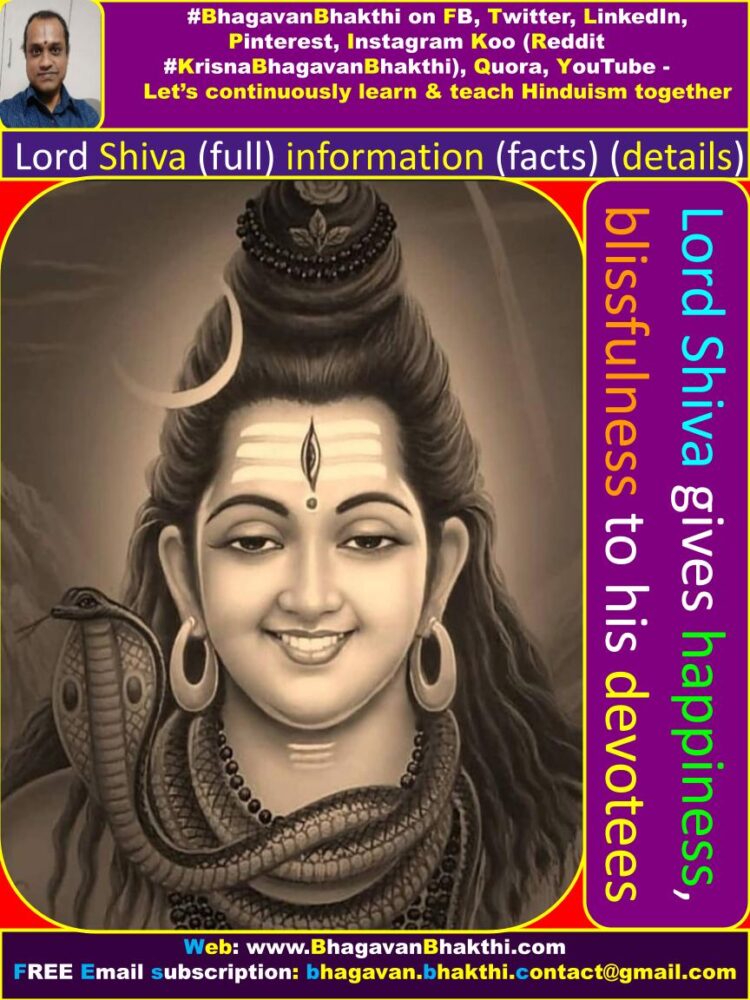
Sharva : Lord Shiva is ‘laya karta‘ (doer of annihilation) with the blessings of Lord Sri Maha Vishnu and thus the name Sharva.
Shiva : Lord Shiva is mangalakara, that is, he is someone who gives all the good destiny / auspiciousness and thus Lord Shiva is known as “Shiva”.
Vamadeva (Vaamadeva) : “Vaama or Vama” means highly sundara / handsome / beautiful / delightful / charming / lovely / appealing / pleasing / etc.
After Lord Sri Vishnu, Goddess Sri Lakshmi Devi, Lord Sri Brahma Deva, Goddess Sri Sarasvati Devi, Lord Sri Vayu Deva, Goddess Sri Bharati Devi, Lord Shiva is ‘atee-sundara‘ (means very very beautiful and handsome).
That is why Lord Shiva is called as Vaamadeva or Vamadeva. Vamadeva = Vama + Deva = Beautiful + God.
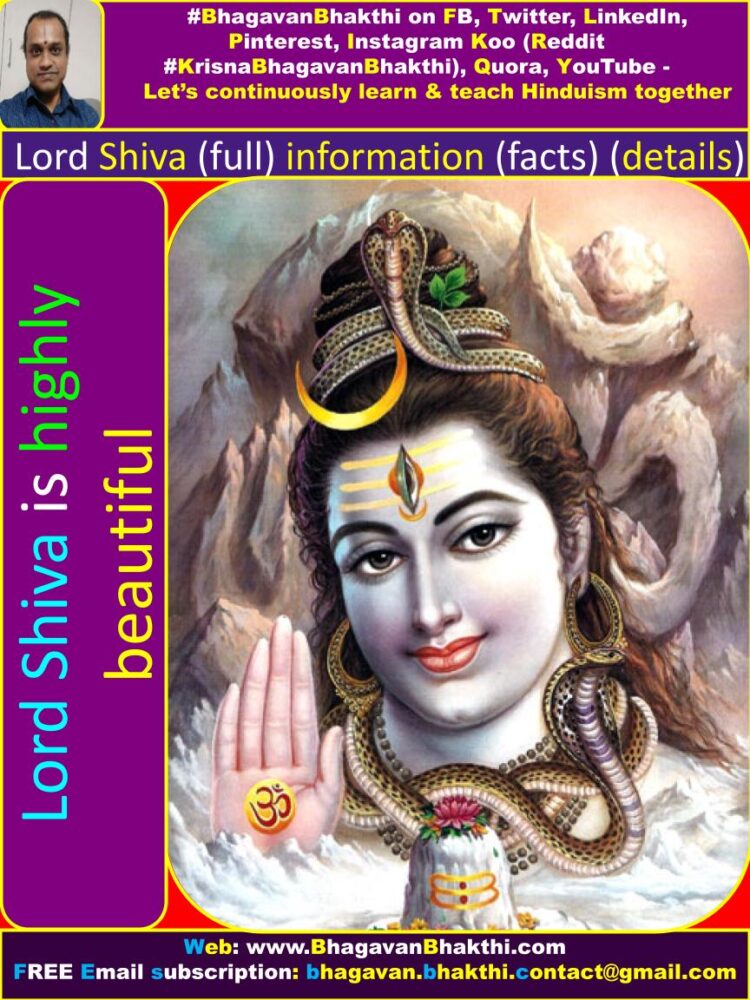
Vamadeva (Vaamadeva) : Lord Shiva is called as Vaamadeva as Lord Shiva will always be on the left side of Lord Sri Vishnu. Vamadeva = Vama + Deva = Left side + God.
Virinchiputra : Lord Shiva is the son of Lord Sri Brahma Deva (another name of Lord Sri Brahma Deva is Virinchi).
Vrishadhvaja : Lord Shiva has Vrishabha Dvaja, that is, Lord Shiva has the flag of the Vrishabha (Nandi). Vrishadhvaja = Vrishabha + Dhvaja = Nandi (Animal) + Flag.
Vishakantha : Lord Shiva drinks the left over of ‘hala hala visha (poison), after majority of it was drunk by Lord Sri Vayu Deva.
Thus the throat of Lord Shiva contains the visha (poison) and thus the name Vishakantha.
Trishulapani : Lord Shiva has Trishula in one of his arms. Trishulapaani – Trishula = Trishula, paani = holding in his hand.
Tripurari : Lord Shiva killed the 3 demons known as Tripurasuras with the blessings of Lord Sri Maha Vishnu and thus the name Tripurari.
Trinetra / Trilochana : Lord Shiva has three eyes. Trinetra = Tri + Netra = Three + eyes = Has three eyes.

Trilochana = Tri + Lochana = Three + eyes = Has three eyes. Both Netra and Lochana in Sanskrit means eyes.
Ugra : Lord Shiva is ‘shatru bhayankara‘, that is, Lord Shiva is very difficult to defeat by his shatrus / enemies and thus the name Ugra.
Ugratapas : Lord Shiva has done very very hard tapas for Kalpadi (कल्पादि) paryanta (whole of one Kalpa) for Lord Sri Vishnu and thus the name Ugratapas.
List of Lord Shiva different avatar names is as given below:
1. Dakshinamurthy (Dakshnamurti) | 2. Veerabhadra (Virabhadra) | 3. Durvasa Muni (Maharishi Atri son) | 4. Ashwatthama (Dronacharya son) |
5. Shuka Muni (Son of Lord Sri Veda Vyasa Ji | 6. Pippalada | 7. Sharabha | 8. Bhairava | 9. Grihapati
Lord Shiva avatars in Sanskrit script is as given here : दक्षिणमूर्ति (dakṣiṇamūrti) | वीरभद्र (vīrabhadra) | दूर्वास मुनि (dūrvāsa muni) | अश्वत्थामा (aśvat’thāma) |
शुक मुनि (śuka muni) | पिप्पलाद (pippalāda) | शरभ (śarabha) | भैरव (bhairava) | गृहपति (gr̥hapati)
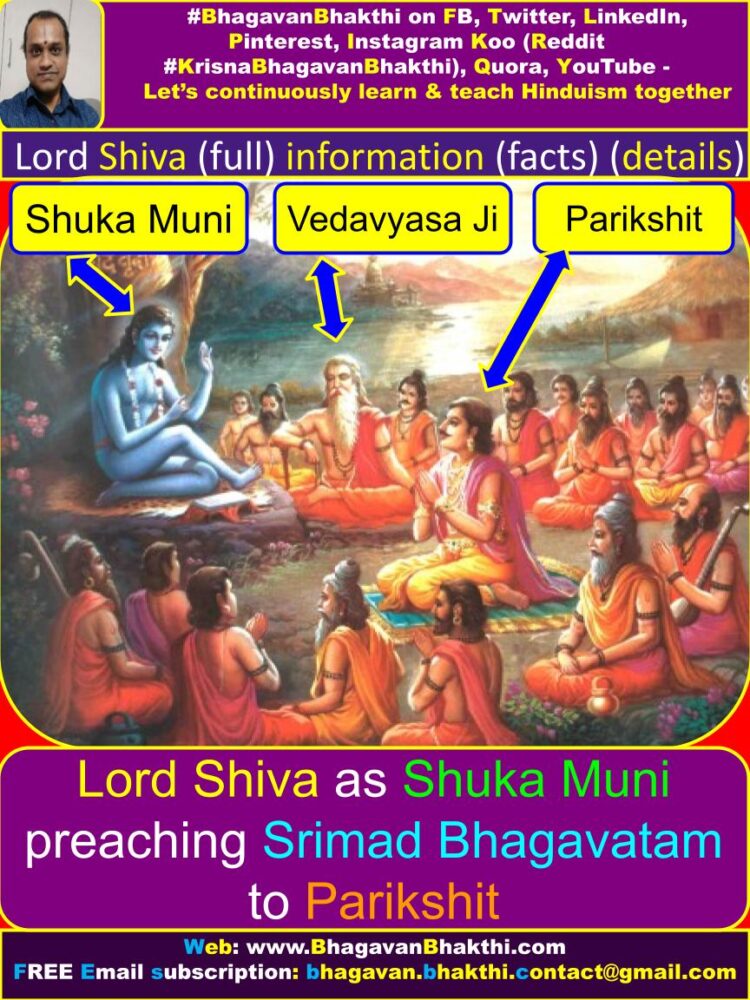
Information about the Lord Shiva’s three forms (roopas) is as given below:
वैकारिक रूप (vaikārika rūpa) (Vaikaarika roopa) | तैजस रूप (taijasa rūpa) (Taijasa roopa) and | तामस रूप (tāmasa rūpa) (Taamasa roopa) |
Vaikarika roopa is Lord Sri Brahma Deva‘s son, Taijasa roopa is Lord Sri Vayu Deva‘s son and Taamasa roopa is Ananta‘s son. {Mahabharata Tatparya Nirnaya Adhyaya 3 (17)}.
(Please remember in the next life Lord Shiva will be son of the present day’s Lord Sri Vayu Deva, that is, in next life Lord Sri Vayu Deva will become Lord Sri Brahma Deva.)
Information about how Lord Shiva got the name Chandrashekara / Somashekhara is as given below:
Daksha Prajapati got married his 27 daughters (names given below) to Lord Sri Chandra Deva.
Ashvinī, (Aswathy) | Bharanī | Kṛttikā (the Pleiades), (Karthika) | Rohinī | Mrigashīra, (Makayiram) | Ārdrā, (Thiruvathira) |
Punarvasu, (Punartham) | Pushya, (Pooyam) | Ashlesha, (Ayilyam) | Maghā, (Makam) | Pūrvaphalgunī, (Pooram) |
Uttaraphalgunī, (Uthram) | Hasta (Atham) | Chitrā (Spica), (Chithira) | Svātī (Arcturus), (Chothi) | Vishākhā, (Visakham) |
Anurādhā or Rādha, (Anizham) | Jyeshtha, (Thrikketta) | Mūla, (Moolam) | Purbashādha or Pūrvashādhā, (Pooradam) |
Uttarashara, (Uthradam) | Shravana, Abhijit, (Thiruvonam) | Dhanistha, (Avittam) | Shatabhisha, (Chathayam) |
Pūrva Bhādrapadā, (Pooruruttathi) | Uttarbhadrapada, (Uthruttathi) | Revatī (Revathi) |
But Lord Sri Chandra Deva showed special care to Rohini (Rohini Devi) amongst 27 wives.
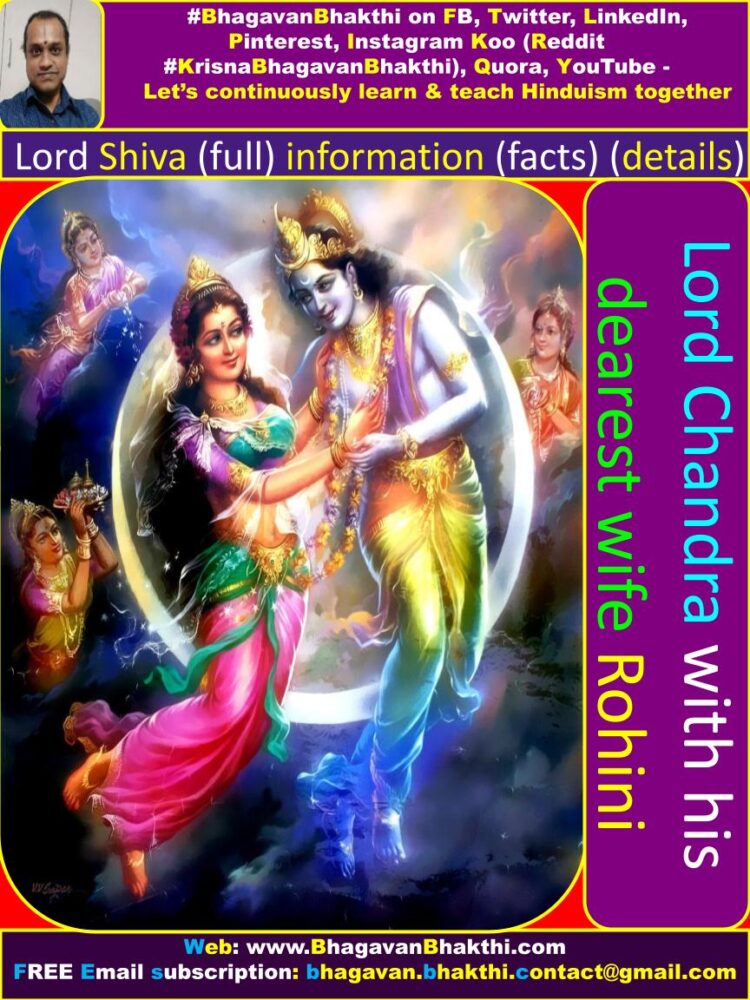
[Lord Sri Chandra Dev did so, because in this Nakshatra Lord Sri Krishna would be born in Dvapara Yuga.]
[So, Lord Sri Chandra Deva showed special affection to Rohini nakshatra abhimani Devata (controlling God) Rohini.]
On seeing this, other wives complained to his father Daksha Prajapati, that Lord Sri Chandra Deva is not looking after all his wives equally.
For this Daksha Prajapati got angry, and cursed Lord Sri Chandra Deva to have ”kshaya” (tuberculosis) disease.
Thus, Lord Sri Chandra Deva was affected by this disease and started losing his quality, and also started to deteriorate to a very very tiny size.
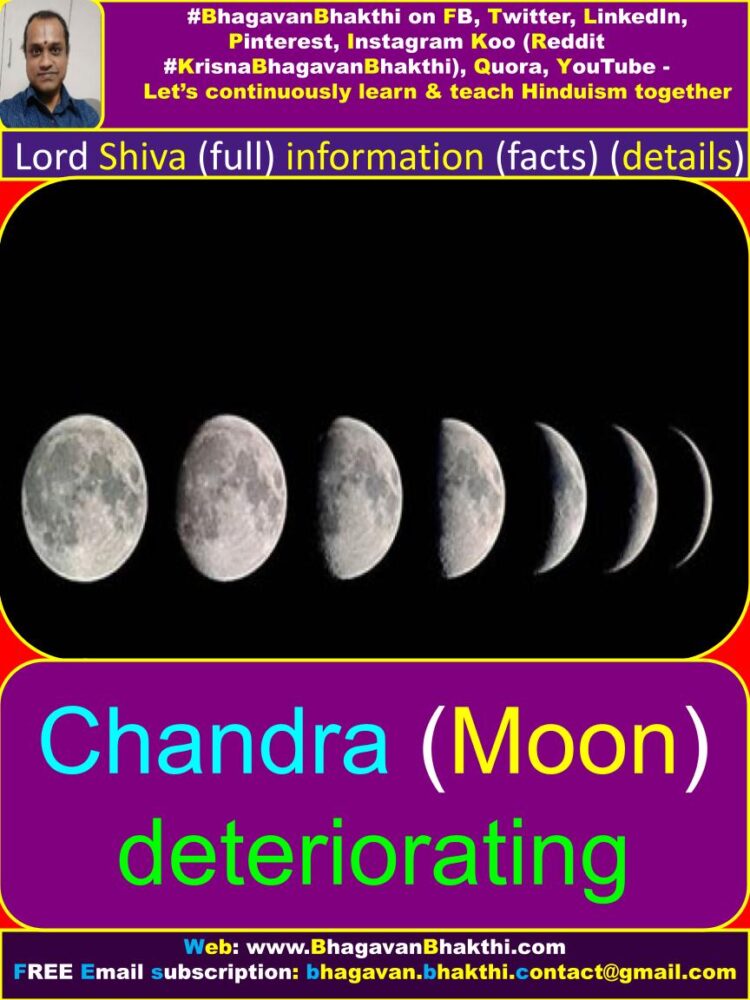
Lord Sri Chandra Deva went to Lord Shiva and sought his assistance and thus Lord Shiva kept him on his head.
Thus Lord Shiva became “Chandrashekara” / “Somashekhara” and told him never to go out of his head.
Lord Sri Chandra Deva’s wives not finding Lord Sri Chandra Deva anywhere, again pleaded his father Daksha Prajapati, to search for their husband.
Not able to trace Lord Sri Chandra Deva, Daksha Prajapati came to know that Lord Sri Chandra Deva was given refuge in Lord Shiva’s head.
Daksha Prajapati asked Lord Shiva to leave Lord Sri Chandra Deva. But Lord Shiva refused saying that once he gives protection, he can’t leave him.
Both Daksha Prajapati and Lord Shiva went to Lord Sri Vishnu, who came in the disguise of a Brahmachari and gave the pratibimba (mirror image) of Lord Sri Chandra Deva to his wives.
The original Lord Sri Chandra Deva was there on the head of Lord Shiva, the Lord Sri Chandra Deva which we are seeing on the sky, is the pratibimba (amsha / mirror image of Lord Sri Chandra Deva) which Lord Sri Vishnu gave to us taking out of Lord Shiva.
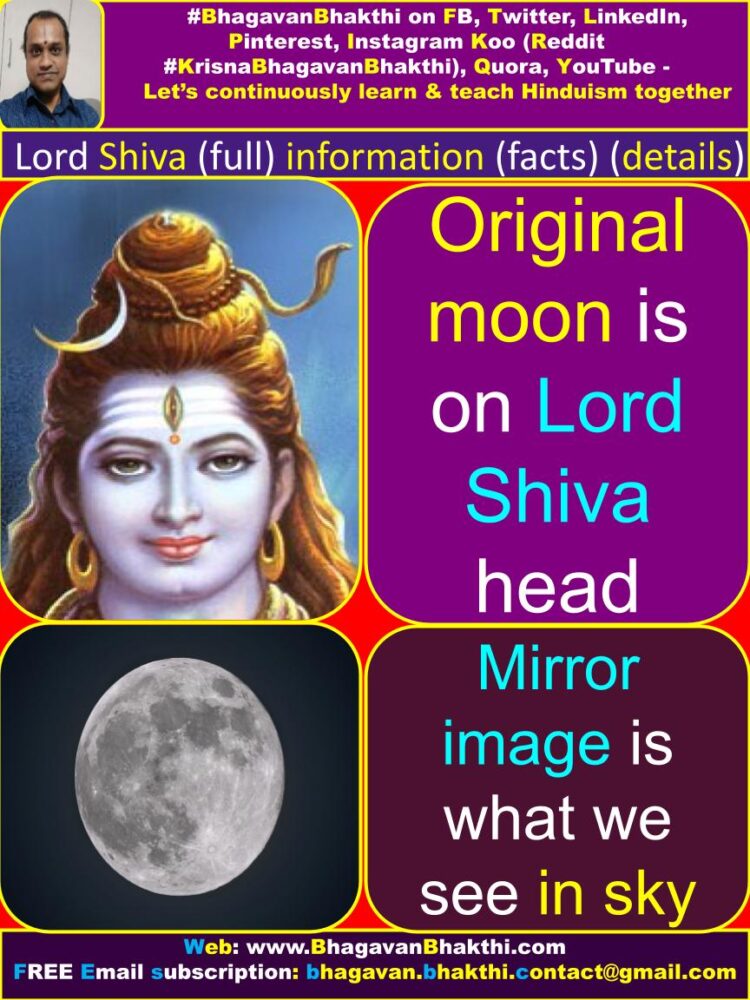
Devatas (Demigods) have amshamshibhava and not like ordinary humans, that is, Devatas (Demigods) can stay in two or more forms in a single given time.
So, one amsha (part) of Lord Sri Chandra Deva was taken out from Lord Shiva and gave to Daksha Prajapati.
Thus Lord Sri Chandra Deva decided to do samsara (sansar) (family) with his 27 wives equally. That is why we have one month called as Nakshatra Maasa.
[Source Brahma Vaivartha Purana by Lord (Sage) Sri Vedavyasa Deva Ji.]
Lord Shiva different avatars are as given below:
1. Dakshinamurthy (Dakshnamurti) | 2. Veerabhadra (Virabhadra) | 3. Durvasa Muni (Maharishi Atri son) | 4. Ashwatthama (Dronacharya son) | 5. Shuka Muni (Son of Lord Sri Veda Vyasa Ji |
Lord Shiva avatars in Sanskrit script is as given here : दक्षिणमूर्ति (dakṣiṇamūrti) | वीरभद्र (vīrabhadra) | दूर्वास मुनि (dūrvāsa muni) | अश्वत्थामा (aśvat’thāma) | शुक मुनि (śuka muni) |
1. Dakshinamurthy (Dakshinamurti) : Dakshinamurthy or Dakshnamurti is an aspect of Lord Shiva as a Guru (teacher) of all types of divine knowledge.
This avatar of Lord Shiva symbolize Lord Shiva as a teacher of wisdom, yoga, music, and also giving explanation about the Hindu Shastras (Hindu Texts).
Dakshinamurti in Sanskrit means ‘someone who is facing towards south side (dakṣiṇa)‘.
In many of the Lord Shiva temples, a deity of Dakshinamurthy (Dakshinamurti) is installed, facing towards south direction. Probably of all Hindu Gods, Lord Shiva is the only one sitting facing south.
In Ujjain (Avanti), Lord Shiva is called as ‘Mahakaleshwar (Mahakal) (Mahakaleshwara)’ and this deity is facing towards south direction.
Another meaning of Dakshinamurthy (Dakshinamurti) is that, Lord Shiva always has Lord Sri Vishnu on his (Lord Shiva’s) right side.
In Sanskrit Dakshina also means towards right side. In any correct image or painting, we can always see Lord Shiva has Lord Sri Vishnu on his right side.
(This is similar to Pradakshina (Pra + Dakshina). We always do Pradakshina by keeping the deity on our right side. In the same way, Lord Sri Vishnu is on the right side of Lord Shiva.)
2. Veerabhadra (Virabhadra) : Veerabhadra (Virabhadra) is a fierce and fearsome avatar of Lord Shiva.
Veerabhadra (Virabhadra) was created by the wrath of Lord Shiva and destroyed the Daksha Prajapati’s Yagna (fire sacrifice).
This happened after Daksha Prajapati’s daughter and Lord Shiva’s consort Goddess Sri Sati Devi self-immolated in the Yagna fire.
Veerabhadra (Virabhadra) is explained as a warrior who eventually blinded Bhaga, subdued Lord Sri Indra Deva and broke Pushana’s teeth.
Other Devatas (Demigods) fled the battlefield unable to sustain his power of Veerabhadra (Virabhadra).
Veerabhadra (Virabhadra) had five sons and two grand sons named Pona Bhadra, Jakha Bhadra, Kalhana Bhadra, Brahma Bhadra, Ati Sura Bhadra, Dahi Bhadra and Anjana Jata Shankara.
3. Durvasa Muni : Durvasa Muni is the son of Maharishi Atri. Durvasa Muni’s brothers names are Dattatreya and Chandra.
Dattatreya is an avatar of Lord Sri Vishnu and Chandra is a part (amsha) avatar of Lord Sri Brahma Deva, as he doesn’t has direct avatar on earth.
4. Ashwatthama : In the Great Epic of Mahabharata, Ashwatthama is also called as Drauni as he was the son of Drona (Dronacharya) (father) and Kripi (mother) (She is the sister of Kripacharya).
Ashwatthama is the grandson of the Maharishi (Sage) Bharadwaja.
Ashwatthama ruled the northern region of Panchala (Drupada’s place) and also acted as the subordinate ruler of Hastinapura.
Ashwatthama was a Maharathi (महारथी) (mahārathī) who fought on the Kaurava (Duryodhana) side and against the Pandavas in the Mahabharata (Kurukshetra) War.
Ashwatthama became a Chiranjivi (immortal) due to the blessing of his moola (original) form of Lord Shiva.
Similarly Ashwattham was cursed by Lord Sri Krishna to suffer in penance after the Kurukshetra war for attacking the womb of Uttara.
5. Shuka Muni (Shukacharya) : Shuka Muni is also called as Shukacharya (Not Shukracharya) or Śuka or Shukadeva or Śuka-Deva.
Shuka Muni is the son of the Lord (Sage) Sri Vedavyasa Ji and the main narrator of the Hindu Text Srimad Bhagavata Purana.
Most of the Srimad Bhagavata Purana consists of Shuka reciting the story to the king Parikshita (Parikshit) in his final days.
Shuka Muni is a sannyasi, that is, someone who has renounced the world in pursuit of moksha (liberation).
Ekadasha (Eleven) Rudras information is as given below:
Ekadasha Rudras are a class of Vedic deities, that is, they are eleven (11) in number along with Dvadasha (12) Aadityas + Ashta (8) Vasus + Prajapati + Vashatkara, they form a significant group of 33 principal Devatas (Demigods).
Ekadasha Rudras nomenclatures differ in different sacred texts and puranas and there is no unanimity in the list.
(Note : This could be because of the same set known by various names. This is similar to one person have more than one name.)
These Ekadasha Rudras represent Lord Shiva as the Rudra or Maha Rudra.
In Bhagavad Gita (Vibhoothi Yoga), Lord Sri Krishna says that “I (Lord Sri Krishna) am the Shankara among Ekadasha Rudras“.
Ekadasha (11) Rudras names are as given below:
(According to Padma Purana/Srimad Bhagavatam)
Manyu | Manu | Mahanasa | Mahan | Shiva | Rta-Dhvaja | Ugra-Reta | Bhava | Kaala | Vaamadeva | Dhrta-Vrata |
Other famous names of Lord Shiva are as given below:
Chandrasekhara | Viswanatha | Maheshwara | Ishwara | Virupaaksha | Nataraja | Dhurjati | Pinaaki | Sarangapaani | Tripuraari etc.
To know more names of Lord Shiva with meaning you can visit this link:
Lord Shiva names with correct meaning
Sacred granthas / texts information about Lord Shiva are as given below:
Sacred Granthas (Texts) like Shiva Purana, Linga Purana and Skanda Purana which forms part of the ‘Ashtadasha (18) Puranas‘ written by Lord (Sage) Sri Vedavyasa Ji have exclusively covered about Lord Shiva.
Sacred shlokas / hymns of Lord Shiva are as given below:
Shiva Panchakshari (Om! Namah! Shivaayah!) | Maha Mrutyunjaya Mantra | Rudram-Namakam-Chamakam
Lord Shiva family member names are as given below:
Lord Shiva | Goddess Sri Parvati Devi is his consort | Lord Ganesha is his elder son | Lord Kartikeya is his younger son | Nandi is the vehicle of Lord Shiva |
Simha is the vehicle of Parvati Devi | Mushaka is the vehicle of Lord Ganesha | Mayura is the vehicle of Lord Kartikeya | And many Ganas
Information about what Lord Shiva loves most is as given below
Lord Shiva is called ‘Abhisheka Priya‘ (loves anointing) and Lord Shiva is also called as ‘Stotra Priya‘ (loves if someone chants his names).
If someone worships Lord Shiva with Abhisheka, Bilva (Bael) Patra (leaves), chanting of his name (Panchakshari mantra etc), worshiping during Pradosha time, Lord Shiva becomes very happy and blesses that devotee enormously.
Information about why Bilva (Bael) Patra (leaves) is very dear to Lord Shiva is as given below:
Bilva (Bael) Patra (leaves) is considered as ‘Goddess Sri Maha Lakshmi Devi Svaroopam‘ (Form of Goddess Sri Lakshmi Devi).
That is, directly (Svayam) Goddess Sri Sri Lakshmi Devi resides in Bilva (Bael) Tree.
Lord Shiva being the ‘Greatest Vaishnava‘ will be very much pleased, if someone worships Him with ‘Bilva (Bael) Patra (leaves)’.
This ‘Bilva (Bael) Patra (leaves)’ got manifested from Goddess Sri Lakshmi Devi the divine consort of Lord Sri Vishnu.
Information about Lord Shiva calendar is as given below:
Though Lord Shiva can be worshiped on a daily basis, some of the important days earmarked for his worship of Lord Shiva are as give below:
Kartika masam | Monday (Somavara / Induvaara) | Pradosha time (1½ hours before Sunset) every day |
Maha Pradosha on the 13th lunar day (Trayodashi) of both Shukla Paksha and Krishna Paksha Masa |
Shivaratri day (14th day of dark fortnight – lunar day Chaturdashi) | Maha Shivarathri day |
On the lunar day coinciding with Ardra Nakshatra | Soma Pradosha (Pradosha associated with Monday)
Bhouma Pradosha (Pradosha associated with Tuesday) | Shani Pradosha (Pradosha associated with Saturday)
Information about Maha Shivaratri is as given below:
The great Maha Shivaratri means the auspicious ratri (night) belonging to Lord Shiva and this day is his most favorite day for Lord Shiva.
There are several interpretations regarding the origin of Maha Shivaratri. Few of them are as given below:
Maha Shivaratri is one of the day that Lord Shiva emerged out in the divine world in Linga Roopa (form), that is, as Jyotirlinga.
Maha Shivaratri is the day that Lord Shiva got married with his consort Goddess Sri Parvati Devi.
That’s why we find a custom of performing ‘Kalyanotsavam‘ (festival of marriage) of Lord Shiva and Goddess Sri Parvati Devi on the day of Maha Shivaratri.
Maha Shivaratri is the day Lord Shiva drank ‘Haalaahala visha / pashan‘ (poison) in the episode of ‘Kshirasaagara Manthan‘ (Amrit Manthan) (Samudra Manthan) (Churning of Ocean).
Maha Shivaratri is the day Lord Shiva performed his cosmic dance called Pralaya Tandava (प्रळय ताण्डव) (praḷaya tāṇḍava).
There may be several reasons for origin of Maha Shivaratri. But Maha Shivaratri is the most favorite day of Lord Shiva and worshiping Lord Shiva on this day is highly meritorious and sin remover.
Information about how to recognize Maha Shivaratri day is as given below:
As per Hindu Sanatana Dharma Chandramana or Lunar Calendar, every ‘chaturdashi‘, that is, 14th lunar day of the Krishna paksha (dark fortnight) is known as Maasa Shivaratri (Monthly Shivaratri).
Sometimes it may fall on the ‘Trayodashi‘ (13th day) also.
It is decided based on the presence of ‘Chaturdasi tithi‘ (14th day) extending beyond midnight on that particular day.
At the same time, every ‘Trayodashi‘ (13th) or ‘Chaturdashi‘ (14th) day of the Krishna Paksha (dark fortnight) is not considered as Maha Shivaratri. These days are considered only as ‘maasa Shivaratri‘ (monthly Shivaratri).
It is only the ‘Trayodashi‘ (13th) or ‘Chaturdashi‘ (14th) day of Krishna Paksha (dark fortnight) occurring in the Chandramana / lunar month of Magha Masam (month) associated with ‘Chaturdashi tithi‘ is recognized as ‘Maha Shivaratri‘.
Generally it occurs in the Gregorian calendar months of February / March.
Information about customs & traditions related to Maha Shivaratri are as given below:
The great day of Maha Shivaratri is dedicated exclusively to Lord Shiva is celebrated with great religious significance and fervor across the country by all Hindus irrespective of the caste and creed.
These customs may differ according to one’s sampradaya / tradition:
In general some of the traditions in vogue are as given below:
Following austerities like doing upavasa (fasting), keeping sleepless vigil (Jaagarana) whole night; break the fast next day morning after worship.
Nine day celebrations called Shivaratri Brahmotsavam are held at famous Shiva Kshetras like Srisailam, Sri Kalahasthi, etc.
Abhisheka with water, Bilva Patra, bathing Shiva Linga with Panchamrita (five ingredients – milk, curd, ghee, honey, sugar).
Worshiping Lord Shiva four times on this day at successive intervals of three hours (Prahara / Yaama) each during night on the day of Maha Shivaratri
Shiva and Parvati Kalyanam (marriage) is also held at some places on the occasion of Maha Shivaratri.
Special celebrations are held on the eve of Maha Shivaratri at all the holy Shiva Kshetras.
Here lakhs of people gather to offer their obeisances and salutations to Lord Shiva. Lord Shiva is the great destroyer of sins and one of the most the benevolent God.
Information about famous Lord Shiva Kshetras (Divine pilgrimage places) is as given below:
While there are several tirtha sthalas (pilgrimage places) and temples dedicated to Lord Shiva spread across Indian sub continent.
But among them, twelve holy places called a ‘Jyotirlinga Kshethras‘ and five holy places called ‘Pancha Bhoota Linga Kshetras‘ are considered as the most revered places for the worship of Lord Shiva.
List of the famous Lord Shiva Kshetras (Jyotirlingas) (Divine pilgrimage places) are as given below:
1. Bhimashankar in Maharashtra near Pune (Maharashtra) | 2. Ghrishneswhar (Maharashtra) | 3. Rameshwar at Rameswaram (Tamil Nadu) |
4. Vaidyanath at Deogarh (Bihar) – According to some versions Vaidyanath is in Parli (Maharashtra) | 5. Nageshwar (Darukavana) near Dwaraka in Gujarat |
6. Tryambakeshwar (Trimbakeshwar) at Nasik (Maharashtra) | 7. Kedarnath in Himalayas (Uttarakhand) | 8. Somnath near Veeraval in Gujarat (Sourashtra) |
9. Mahakal (Mahakaleshwar) at Avanti (Ujjain) Madhya Pradesh | 10. Omkareshwar at Khandwa at Madhya Pradesh |
11. Vishwanath at Kashi (Varanasi), Uttar Pradesh | 12. Somnath (Somanath) (Somanath) at Somnath, Gujarat |
Information about Pancha Bhoota Linga Kshetras is as given below:
Lord Shiva is considered as an embodiment of ‘Pancha Bhootas‘, that is, the five basic elements of nature, i.e., Aakasha (sky / space), Vaayu (air), Prithvi (earth), Jala (water) and Agni (fire).
Lord Shiva had manifested at the following places which are regarded as the Pancha Bhootha Shiva Kshetras (pilgrimage places):
Chidambaram (Aakasa Linga), in Tamil Nadu | Kanchi (Prithvi Linga), in Tamil Nadu | Sri Kalahasthi (Vayu Linga) in Andhra Pradesh |
Thiruvannaikkaval (Jala Linga) near Trichy (Tamil Nadu) | Tiruvannamalai (Agni Linga) in Tamil Nadu
To watch videos on #Hinduism #Sanskrit language, SUBSCRIBE to my YouTube channel from this below link:
#BhagavanBhakthi YouTube channel
Continue reading to know about “Lord Shiva (full) information (facts) (details) – Part 1 of 2” from this below link:
Lord Shiva (full) information (facts) (details) – Part 1 of 2
To know more names of Lord Shiva with meaning you can visit this link:
Lord Shiva names with correct meaning
To know more information on Lord Shiva and Shivaratri, you can visit this below link:
Lord Shiva, Shivaratri, other significances
To watch Modi chanting Har Har Mahadev secret | Importance of chanting Har Har Mahadev YouTube video, click the below YouTube video link:
Dear friends, if you need any clarifications about this post, kindly let me know, I will definitely try to answer all of them.
Also your one LIKE, one COMMENT, One Share, one SUBSCRIPTION is highly important.
This will help to know the quality of this content and also it will be helpful to know if any improvements is required for the content.
If you feel this content is useful to you and has helped you to improve your knowledge, kindly share this with your well-wishers.
Because “SHARING MEANS CARING”.
To receive FREE EMAIL SUBSCRIPTION about #BhagavanBhakthi, you can send an email to bhagavan.bhakthi.contact@gmail.com from your email ID.
NAMASTE!
Sri Gurubhyo Namaha
Sri Krishnaaya Namaha
Sri Krishnaarpanamastu
Subscribe / Follow us Share in Social Media
Im no longer certain the place you’re getting your information, but great topic. I must spend some time studying much more or understanding more. Thanks for wonderful info I was on the lookout for this information for my mission.